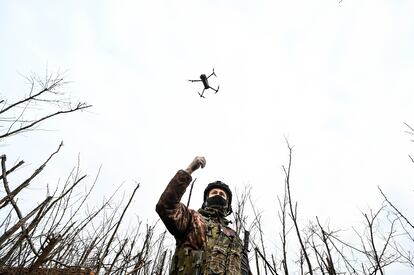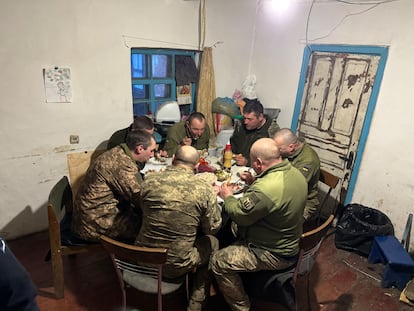Ukraine launches wave of drone attacks on nine Russian regions on eve of presidential election
The strikes targeted infrastructure and reportedly destroyed a Lukoil refinery and a fuel depot while Russian pro-Ukraine paramilitaries fought Kremlin troops in border skirmishes


Ukraine has launched fresh attacks on Russian soil a few days before the Russian presidential election. At least nine regions of the country were targeted by Ukrainian drones, which have caused damage to several refineries and fuel depots in the country. At the same time, Vladimir Putin’s armed forces clashed Tuesday with the Siberian Battalion and the Freedom of Russia Legion — formed by Russian volunteers fighting alongside Kyiv against the Kremlin — on the borders of the regions of Belgorod and Kursk in northern Ukraine. The assault began at night led by small units of paramilitaries supported by armored vehicles, Russian military channels have revealed. The Ukrainian-allied militias claim to have penetrated Russian territory, while Moscow said the attacks were repulsed and large number of enemy combat vehicles destroyed. At least two civilians have been wounded in the skirmishes, although casualty figures on both sides are unclear.
Kyiv has avoided confirming having launched dozens of drones over Russia on Tuesday. According to the Russian Defense Ministry and regional governors, the provinces attacked were Moscow, St. Petersburg, Tula, Oryol, Bryansk, Nizhny Novgorod and the border provinces of Voronezh, Belgorod, and Kursk.
Although the Defense Ministry claimed to have intercepted 25 drones, several projectiles evaded anti-aircraft measures. Ukraine has targeted the Russian energy and manufacturing industry in recent months, hitting at least two targets on Tuesday. In Nizhny Novgorod, west of Moscow, a refinery belonging to Russian oil giant Lukoil burned down. Several drones hit the Kstovo facility, according to the TASS news agency. Another fuel depot in Oryol province was destroyed by a drone strike on Monday.
Another drone hit the town hall in the city of Belgorod, located just 25 miles from the northern Ukrainian border, on Tuesday morning. The explosion, which caused minor damage to the building’s facade, resulted in two casualties. One woman was injured by shrapnel and another suffered a concussion.
Plane crash with 15 people on board
In addition to the attacks, the Russian armed forces suffered further casualties on Tuesday. An Il-76 cargo plane crashed after takeoff from a base in Ivanovo province, located just over a 60 miles northeast of Moscow. According to the Defense Ministry, the cause of the accident was an engine failure. The aircraft remained airborne for about seven minutes before crashing to the ground. Russian media report that all eight crew members and seven passengers on board were killed.
The Ukrainian attacks were accompanied with fresh skirmishes on the Russian border more than six months after Kyiv took similar action just before launching its failed summer 2023 counteroffensive. “We often say that it is not possible to peacefully overthrow the dictatorial and criminal regime in the Russian Federation; it can only be ended with weapons in hand. Tonight we begin to fulfill the promise,” the Siberian Battalion announced on its Telegram channel after starting the operation. The Freedom of Russia Legion, made up of far-right Russians, meanwhile posted a video of an armored car allegedly crossing the border at night. Neither the date of the recording nor the images could be verified.
“We will take our land from the regime inch by inch,” the Freedom of Russia Legion has promised on its channel. The battalion, trained in Ukraine with heavy weaponry, waged similar operations on Russian soil in the spring and summer of 2023. Back then, Kyiv’s aim was to sow confusion among the Russian population and force Putin to withdraw troops from the frontline to reinforce its borders on the eve of the Ukrainian offensive.
Russian military bloggers’ sources have claimed that fighting was continuing in isolated areas at noon on Tuesday, although the Russian Defense Ministry emphasized that the Ukrainian operation has been “foiled” and its paramilitaries have suffered “significant losses.” “No violations of the state border were allowed,” it said.
The Russian Defense Ministry and Federal Security Service (FSB) issued separate statements claiming to have wiped out a sizeable force in several battles. According to their figures, Russian forces killed at least 160 paramilitaries and destroyed nine tanks and more than 20 armored vehicles. However, Moscow offered no verifiable images or any figures for its own casualties.
Some Kremlin-friendly media reports give an idea of the Ukrainian incursion. Andrei Rudenko, a correspondent for Russian state television, affirmed that inside the Belgorod region there were enemy “reconnaissance actions,” while the Russian military blogger Starshe Eddy admitted that along several stretches of the border “very intense fighting is going on.” Well-known blogger Wargonzo revealed that a column of vehicles carrying 500 paramilitaries launched an assault on Russia from the Ukrainian region of Kharkiv.
One of the hot spots was the border village of Tetkino, where at least one civilian was wounded, according to the independent Russian media Baza. The village in the Kursk region, located less than two miles from Ukraine, “is under constant shelling,” the governor of the province, Roman Starovoit, confirmed. The official posted a short video on Telegram in which he admitted “there was fighting” in the area, but he stated, without providing further details, that the pro-Ukraine paramilitaries “did not manage to make any breakthrough.”
Sign up for our weekly newsletter to get more English-language news coverage from EL PAÍS USA Edition
Tu suscripción se está usando en otro dispositivo
¿Quieres añadir otro usuario a tu suscripción?
Si continúas leyendo en este dispositivo, no se podrá leer en el otro.
FlechaTu suscripción se está usando en otro dispositivo y solo puedes acceder a EL PAÍS desde un dispositivo a la vez.
Si quieres compartir tu cuenta, cambia tu suscripción a la modalidad Premium, así podrás añadir otro usuario. Cada uno accederá con su propia cuenta de email, lo que os permitirá personalizar vuestra experiencia en EL PAÍS.
¿Tienes una suscripción de empresa? Accede aquí para contratar más cuentas.
En el caso de no saber quién está usando tu cuenta, te recomendamos cambiar tu contraseña aquí.
Si decides continuar compartiendo tu cuenta, este mensaje se mostrará en tu dispositivo y en el de la otra persona que está usando tu cuenta de forma indefinida, afectando a tu experiencia de lectura. Puedes consultar aquí los términos y condiciones de la suscripción digital.
More information
Archived In
Últimas noticias
The digitalization of tourism: ‘They promise experiences and gave us the worst possible one’
Mexican peso defies uncertainty with forecasts of a new period of stability in 2026
Meghan Markle’s year of redemption: Numerous projects, some setbacks and a brand that is finally taking off
David King, chemist: ‘There are scientists studying how to cool the planet; nobody should stop these experiments from happening’
Most viewed
- Sinaloa Cartel war is taking its toll on Los Chapitos
- Oona Chaplin: ‘I told James Cameron that I was living in a treehouse and starting a permaculture project with a friend’
- Reinhard Genzel, Nobel laureate in physics: ‘One-minute videos will never give you the truth’
- Why the price of coffee has skyrocketed: from Brazilian plantations to specialty coffee houses
- Silver prices are going crazy: This is what’s fueling the rally










































